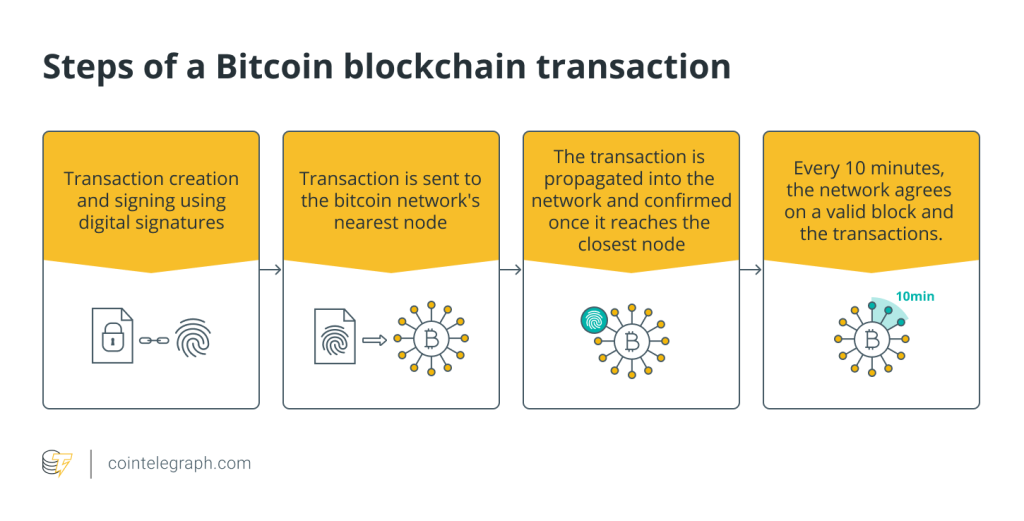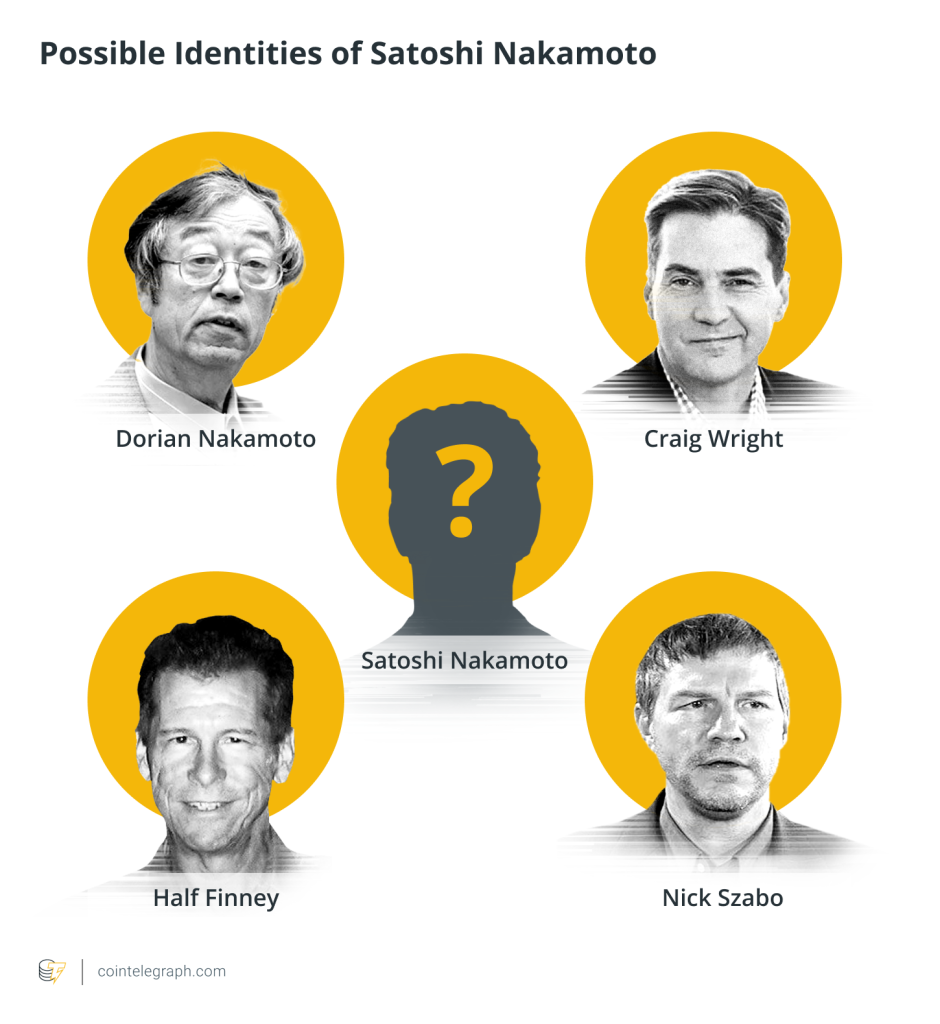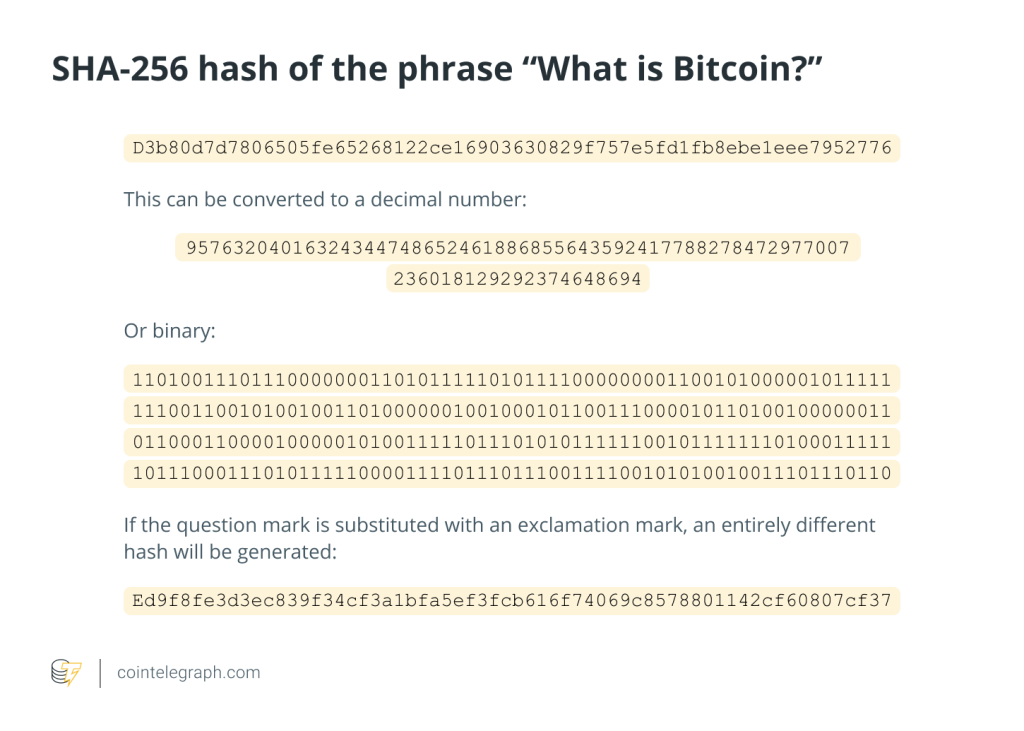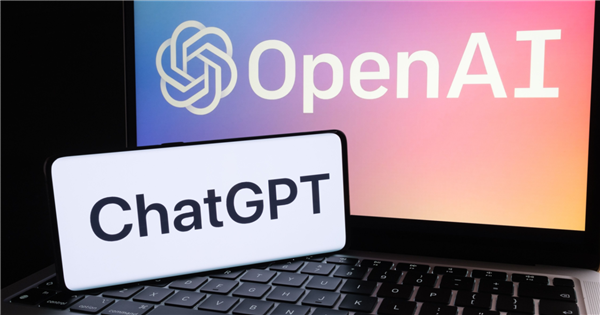What is the Bitcoin blockchain? A guide to the technology behind BTC


The Bitcoin blockchain is an amalgamation of Bitcoin (BTC) and blockchain. A person or a group of people known as Satoshi Nakamoto created the Bitcoin protocol in 2008 to decentralize control of money when centralized entities had failed the world. A publication called the Bitcoin white paper outlined a set of computational rules that determined a new type of distributed database: the blockchain. The network was launched in January 2009.
The most well-known cryptocurrency, Bitcoin, is the one for which blockchain technology was created. Like the United States dollar, a cryptocurrency is a digital means of exchange that uses encryption techniques to oversee the establishment of monetary units and verify financial transfers.
The Bitcoin blockchain refers to the data stored in “blocks” of information that are then linked together in a permanent “chain.” A block is a collection of Bitcoin transactions from a specific period. Stacks of blocks are stockpiled on top of each other, with each new block relying on the previous ones. As a result, a chain of blocks is formed, giving rise to the word “blockchain.”
Every time a new block is added, it makes the previous blocks unmodifiable. This ensures that each block is more secure over time, and it is an example of how Bitcoin technology is changing how banking and financial transactions are being made.
Bitcoin blockchain, however, is much more than cryptocurrency: It is the technology that most cryptocurrencies are built on, including Bitcoin. The Bitcoin blockchain is unique because it ensures that all transactions are accurate. Every action in the blockchain is recorded and there is nothing that is left out of the network. Once an action is recorded and stored in one of the information blocks, it is time-stamped and secured, and the entire record is available to anyone in the system.
The Bitcoin blockchain is also decentralized, meaning it is not stored in one master computer or controlled by one company. It is distributed on many computers that are in the network.
In the Bitcoin blockchain, there are codes called a hash. A hash is unique to each block in the blockchain. Hashing allows every network user to identify each block and directs them to move in the chain since every block has its own hash and a previous block's hash.
With the latter in mind, the critical parts of the blockchain include records, block, hash and chain. Block records and transactional records are the two types of records in the blockchain. A block contains the most recent Bitcoin transactions that have not yet been recorded in any previous block. Transaction records include the asset, price and ownership data that are recorded, approved and settled across all nodes in seconds.
In essence, a hash is a fixed-length string generated after transforming any length of input data in the blockchain network, a block is similar to a page in a ledger or record book and a chain refers to blocks linked together in a network.
Short story of Bitcoin blockchain
The idea of blockchain technology was introduced in 1991 by Stuart Haber and W. Scott Stornetta in their paper “How to Time-Stamp a Digital Document.” In this paper, they explained the use of a continuous chain of timestamps to record information securely.
Bitcoin was created largely to facilitate the exchange of Bitcoin cryptocurrency. However, early adopters and inventors rapidly discovered that it had far greater potential. With this in mind, they designed Bitcoin's blockchain to store more than just data on the token's movement.
Bitcoin technology uses peer-to-peer (P2P) transactions, making it possible to function without any bank or third party to manage each financial movement. It allows online payments to be sent directly from one party to another without going through any financial institution.
Related: The history of Bitcoin: When did Bitcoin start?
The term peer-to-peer means that the computers that are part of the network are equal to each other, that there are no “special” nodes and that all nodes share the burden of providing network services. It is made up of thousands of Bitcoin nodes that run the protocol. The protocol is responsible for establishing and safeguarding the blockchain.
The formation of a peer-to-peer network is possible because users' data is related to the person or entity they are interacting with, and they are in charge of keeping the distributed network up and running. The information regarding the individual or entity is then passed from their Bitcoin wallet to their location and IP address, which represents peer-to-peer Bitcoin interaction.
What is needed to make the Bitcoin blockchain work?
Bitcoin represents a digital, trustless form of money, alongside a movement to decentralize financial services. Before Bitcoin, there was a need for a trusted third party to keep a ledger — the record-keeping system of a company's or person's financial data — to record who owned how much. Everyone has a copy of this ledger with the Bitcoin network, so there is no need for third parties.
Every Bitcoin transaction happens in the Bitcoin blockchain network, which is the digital space where Bitcoin mining and hash power generation occur. Hashing power is the processing power used by your computer or hardware to perform and solve various hashing algorithms. These algorithms are used to create new cryptocurrencies and allow them to trade with one another. This process is called mining.
Usually, Bitcoin owners purchase their cryptocurrency supply through a cryptocurrency exchange, a platform that facilitates transactions of Bitcoin and other cryptocurrencies. The decentralized ledger is what makes the blockchain network. The latter shows that Bitcoin is a piece of software, a set of processes in which participants perform different tasks.
A blockchain is a digital ledger of duplicated transactions distributed across the blockchain's network of computer systems. Each block on the chain contains several transactions, and whenever a new transaction occurs on the blockchain, a record of that transaction is added to the ledger of each participant.
This distributed database is managed by multiple participants using a technology called distributed ledger technology (DLT). Blockchain is a type of DLT in which transactions are recorded using an immutable cryptographic signature known as a hash. The transactions are then organized into blocks. Each new block includes a hash of the preceding one, effectively chaining them together, which is why distributed ledgers are commonly referred to as blockchains.

The blockchain works as a ledger, tracking every Bitcoin transaction, and is self-verifying, meaning that the entire network of nodes — different computers participating in the network — will constantly check and secure every movement. Here is where the “miners” come into the game: Their computers do the heavy lifting of maintaining the chain and thus, receive Bitcoin as a reward. These rules, collectively, are the Bitcoin protocol.
Bitcoin miners refer to the high-powered computers solving complex math problems to mint a coin. Miners are network-dedicated machines that verify all transactions and block any malicious actors. Bitcoin miners compile as many transactions as possible into a block, then verify the block and add it to the chain of previous blocks using a mathematical method. For providing their computing power to the network, miners are paid in newly minted Bitcoin.
How does the Bitcoin blockchain work?
A blockchain is a type of database which is a collection of information stored on a computer system electronically. What is kept in databases, information or data is usually structured in a table format that makes it easier to search and filter information. Databases are designed to store large amounts of information that can be accessed, filtered and edited easily and quickly by many users at any time.
To do this, extensive databases house data on servers that are made of potent computers. Those servers can be built using hundreds and hundreds of computers. Why? To have the computational storage and power needed for many users to access the database simultaneously. This is the difference from a database too, let's say, a storage cloud-like drive.
Here’s how a blockchain differs from a database. The first difference is how data is structured. A database structures data into tables, while a blockchain collects information into groups, known as blocks, that hold data sets. Each block has a specific storage capacity that is chained onto the previous filled block when it gets filled, forming a chain of data. That's why it's called the blockchain: Millions of blocks filled with data are chained together.
This system means that every blockchain is a database that is more complex since it creates an irreversible chainline of data when implemented in a decentralized system. When one block is filled, it is unchangeable and becomes part of a timeline, and so, each block on the chain has an exact timestamp when added to the chain.
Thus, the goal of the blockchain is to allow digital information to be recorded and distributed, but not edited. That's why it is not a database per se; no one can change it once it is filled and chained. With the appearance of Bitcoin technology, blockchain had its first actual application.
Reducing risks
Using a blockchain network comes with a lot of advantages. First, the accuracy of the chain. Transactions that are part of the blockchain have to be approved by thousands of thousands of computers. This removes all human involvement in the verification, which means there are fewer human errors, as well as a more accurate record of information.
But, what if one of the computers in the network makes a computational mistake? The error would only be in one copy of the blockchain. For it to spread, at least 51% of the network would need to have the same mistake, which is very unlikely.
Another advantage is that blockchain eliminates the need for third-party verifiers. Any member of the Bitcoin network can check and verify the blockchain at any time.
Blockchain data is decentralized, which means that it is not stored in a central location but instead copied and spread across a vast network of computers. This makes it very hard for anyone to tamper with the data since a kicker, for example, would need access to all of the networks to compromise it fully.
Finally, an instrumental part of the blockchain is that, although anyone with an internet connection can see the list of the network's transaction history and access details about transactions, no one can access identifying information about the users that are making those transactions. Also, every time a transaction is recorded, it is verified by the network, meaning that the thousands of computers that compose it confirm if the details of the purchase are correct.
Blockchain vs. banks
Blockchain works very differently from a traditional bank since it is 100% decentralized and it relies on thousands of computers to verify its transactions. This means it runs 24/7, every day of the year. The most significant advantage of all of the Bitcoin blockchain is its transparency because the blockchain acts as a public ledger for every transaction made in the Bitcoin network.
Other differences are that the speed of the transactions is as little as 15 minutes or as much as over an hour, depending on the network's congestion. While card payments and check deposits can take from 24 to 72 hours.
The Bitcoin blockchain has variable fees, usually ranging from $0 to $50. While the fee is unrelated to the amount being transferred, it is determined by network circumstances at the moment and the transaction's data size. Because a block on the Bitcoin blockchain may only hold one megabyte (MB) of data, the number of transactions included in a single block is limited.
Another difference is in the way of making transactions. While the blockchain allows anyone with an internet connection to make a transfer, banks need you to have an account, a mobile phone, or a computer.
All of these differences make blockchain technology a great disruptor of traditional finances and the banking industry. They are tamper-proof and decentralized, set-in-stone chains that not only reduce costs but create a transparent network in which users can feel empowered and safe.
The limitations of the blockchain
Although the blockchain comes with many benefits, like everything, it has its downsides. The first is that the blockchain can slow down when there are too many users on the network. It is also harder to scale due to its consensus method of work.
Another limitation is that data within the blockchain is immutable, you cannot go back and alter the previous block once it is written. Some may view it as an imitation that requires self-maintenance, which means that users have to maintain their own wallets or else they can lose access.
A big limitation is that blockchain technology is still not mature. Also, it doesn´t offer interoperability with other blockchains and other financial systems, and is hard to integrate into legacy systems.
Technical advances
Lightning Network
The Lightning Network (LN) permits participants to transfer BTC between each other without any fees using their digital wallets. A second layer is added to the Bitcoin network to enable transactions between parties off of the blockchain, which is called off-chain transactions. A second layer boosts throughput without compromising any of the original blockchain's decentralization or security features.
Lightning Network creates payment channels between two users in a distributed database so they can transact with each other, without all the other users receiving their information, defining off-chain transactions.
It is considered a game-changer in the cryptocurrency world since it has been designed to speed up transaction processing and decrease associated costs of the Bitcoin blockchain. It was conceived in 2015 and is being further developed and activated.
However, researchers have cautioned that as the Lightning Network grows, it will become a more appealing target for attackers. Bitcoin on the developing payment network might be stolen if users aren't careful and it may be hard to ensure the safety of assets in the future.
According to experts from the Hebrew University of Jerusalem, Bitcoin that is currently locked in the Lightning Network payments channel, which is currently roughly $9 million in Bitcoin, might be looted by attackers. While the flaw has the potential to be serious, the researchers are optimistic that it is fixable in the long run.
SegWit
Segregated Witness, or SegWit, refers to a process change in how Bitcoin maintains transaction data in the blockchain. Segregate means to separate and witnesses are the transaction signatures. It was created to renew the way in which data is stored on Bitcoin's blockchain. This allows the network to hold more transactions in a single block, enhancing transaction throughput. SegWit went active on Bitcoin in August 2017 after the code for the update was released in 2015.
SegWit increases the block size limit of a blockchain by removing signature data from Bitcoin transactions. When parts of a transaction are removed, space gets freed and so does capacity to add more transactions to the chain.
SegWit not only improved Bitcoin's transaction processing speed but also solved a weakness in the protocol that allowed nodes to tamper with transaction malleability problems (TXIDs) on the network. By removing what is known as “signature data” or “the witness data” from the input field of a block, Segwit increased the number of transactions that could fit into a block and fixed the transaction malleability flaw.
On the Bitcoin network, the SegWit update was introduced as a soft fork in August 2017. A soft fork is a backward-compatible update that allows upgraded nodes to communicate with non-upgraded nodes. A soft fork usually includes a new rule that does not conflict with the existing ones. However, due to the high cost of running a node (especially in developing countries), the upgrade was put on hold on November 8, 2017.
Taproot
Bitcoin Core developer Greg Maxwell proposed the Taproot improvement in January 2018. The 90% criterion of blocks mined with a support signal from miners was met three years later on June 12, 2021. It means that 1,815 of the 2,016 blocks mined throughout the two-week time frame had some encoded data left by miners to demonstrate their support for the upgrade.
Taproot is a soft fork that improves Bitcoin's scripts to enhance privacy and increase anonymity on the network. When a user does not use Taproot, anyone can detect transactions. When using Taproot, they can “cloak” their transactions. Taproot even makes it possible to hide that a Bitcoin script ran at all. As of October 2020, Taproot is merged with the Bitcoin Core library.
One of the most significant changes to the network is the substitution of Schnorr signatures for Bitcoin's current elliptic curve digital signature technique (ECDSA). The ECDSA technique generates public keys from randomly generated private keys, which makes it impossible to determine a private key from a Bitcoin address or public key. Moreover, the Schnorr signature will free up space and bandwidth on the Bitcoin network by making transactions faster and smaller.
By permitting discrete log contracts (DLCs), the Schnorr signature can help simplify complex smart contracts on the Bitcoin blockchain. The DLCs are a proposal to add a smart contract implementation to Bitcoin, allowing the establishment of simple, safe and easy-to-use blockchain oracles.
It may also aid in the scaling of layer-two payment channels such as the Lightning Network, which allows for immediate transactions on the Bitcoin network.






… [Trackback]
[…] Read More on on that Topic: x.superex.com/academys/beginner/2915/ […]
… [Trackback]
[…] There you will find 32546 more Info on that Topic: x.superex.com/academys/beginner/2915/ […]
… [Trackback]
[…] Information on that Topic: x.superex.com/academys/beginner/2915/ […]
… [Trackback]
[…] There you will find 20565 additional Info to that Topic: x.superex.com/academys/beginner/2915/ […]
… [Trackback]
[…] Read More to that Topic: x.superex.com/academys/beginner/2915/ […]
… [Trackback]
[…] Find More to that Topic: x.superex.com/academys/beginner/2915/ […]
… [Trackback]
[…] Find More to that Topic: x.superex.com/academys/beginner/2915/ […]
… [Trackback]
[…] Information on that Topic: x.superex.com/academys/beginner/2915/ […]
… [Trackback]
[…] Find More Information here to that Topic: x.superex.com/academys/beginner/2915/ […]
… [Trackback]
[…] Find More on on that Topic: x.superex.com/academys/beginner/2915/ […]
… [Trackback]
[…] Read More on on that Topic: x.superex.com/academys/beginner/2915/ […]
… [Trackback]
[…] There you can find 46086 additional Info on that Topic: x.superex.com/academys/beginner/2915/ […]
… [Trackback]
[…] Find More here to that Topic: x.superex.com/academys/beginner/2915/ […]
… [Trackback]
[…] Info on that Topic: x.superex.com/academys/beginner/2915/ […]
… [Trackback]
[…] Information on that Topic: x.superex.com/academys/beginner/2915/ […]
… [Trackback]
[…] There you can find 25024 additional Info on that Topic: x.superex.com/academys/beginner/2915/ […]
… [Trackback]
[…] There you will find 35190 more Information to that Topic: x.superex.com/academys/beginner/2915/ […]
… [Trackback]
[…] Information on that Topic: x.superex.com/academys/beginner/2915/ […]
… [Trackback]
[…] Info to that Topic: x.superex.com/academys/beginner/2915/ […]
… [Trackback]
[…] Information to that Topic: x.superex.com/academys/beginner/2915/ […]
… [Trackback]
[…] Info to that Topic: x.superex.com/academys/beginner/2915/ […]
… [Trackback]
[…] Find More Information here to that Topic: x.superex.com/academys/beginner/2915/ […]
… [Trackback]
[…] Information to that Topic: x.superex.com/academys/beginner/2915/ […]
… [Trackback]
[…] Here you can find 36246 additional Information to that Topic: x.superex.com/academys/beginner/2915/ […]
… [Trackback]
[…] Read More Information here on that Topic: x.superex.com/academys/beginner/2915/ […]
… [Trackback]
[…] Find More here to that Topic: x.superex.com/academys/beginner/2915/ […]
… [Trackback]
[…] Information on that Topic: x.superex.com/academys/beginner/2915/ […]
… [Trackback]
[…] Read More here to that Topic: x.superex.com/academys/beginner/2915/ […]